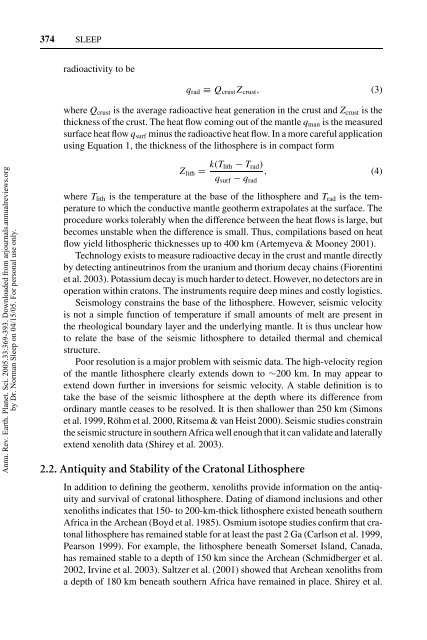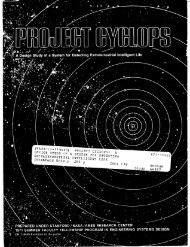evolution of the continental lithosphere - Department of Earth and ...
evolution of the continental lithosphere - Department of Earth and ...
evolution of the continental lithosphere - Department of Earth and ...
You also want an ePaper? Increase the reach of your titles
YUMPU automatically turns print PDFs into web optimized ePapers that Google loves.
374 SLEEP<br />
radioactivity to be<br />
q rad ≡ Q crust Z crust , (3)<br />
where Q crust is <strong>the</strong> average radioactive heat generation in <strong>the</strong> crust <strong>and</strong> Z crust is <strong>the</strong><br />
thickness <strong>of</strong> <strong>the</strong> crust. The heat flow coming out <strong>of</strong> <strong>the</strong> mantle q man is <strong>the</strong> measured<br />
surface heat flow q surf minus <strong>the</strong> radioactive heat flow. In a more careful application<br />
using Equation 1, <strong>the</strong> thickness <strong>of</strong> <strong>the</strong> <strong>lithosphere</strong> is in compact form<br />
Annu. Rev. <strong>Earth</strong>. Planet. Sci. 2005.33:369-393. Downloaded from arjournals.annualreviews.org<br />
by Dr. Norman Sleep on 04/15/05. For personal use only.<br />
Z lith = k(T lith − T rad )<br />
, (4)<br />
q surf − q rad<br />
where T lith is <strong>the</strong> temperature at <strong>the</strong> base <strong>of</strong> <strong>the</strong> <strong>lithosphere</strong> <strong>and</strong> T rad is <strong>the</strong> temperature<br />
to which <strong>the</strong> conductive mantle geo<strong>the</strong>rm extrapolates at <strong>the</strong> surface. The<br />
procedure works tolerably when <strong>the</strong> difference between <strong>the</strong> heat flows is large, but<br />
becomes unstable when <strong>the</strong> difference is small. Thus, compilations based on heat<br />
flow yield lithospheric thicknesses up to 400 km (Artemyeva & Mooney 2001).<br />
Technology exists to measure radioactive decay in <strong>the</strong> crust <strong>and</strong> mantle directly<br />
by detecting antineutrinos from <strong>the</strong> uranium <strong>and</strong> thorium decay chains (Fiorentini<br />
et al. 2003). Potassium decay is much harder to detect. However, no detectors are in<br />
operation within cratons. The instruments require deep mines <strong>and</strong> costly logistics.<br />
Seismology constrains <strong>the</strong> base <strong>of</strong> <strong>the</strong> <strong>lithosphere</strong>. However, seismic velocity<br />
is not a simple function <strong>of</strong> temperature if small amounts <strong>of</strong> melt are present in<br />
<strong>the</strong> rheological boundary layer <strong>and</strong> <strong>the</strong> underlying mantle. It is thus unclear how<br />
to relate <strong>the</strong> base <strong>of</strong> <strong>the</strong> seismic <strong>lithosphere</strong> to detailed <strong>the</strong>rmal <strong>and</strong> chemical<br />
structure.<br />
Poor resolution is a major problem with seismic data. The high-velocity region<br />
<strong>of</strong> <strong>the</strong> mantle <strong>lithosphere</strong> clearly extends down to ∼200 km. In may appear to<br />
extend down fur<strong>the</strong>r in inversions for seismic velocity. A stable definition is to<br />
take <strong>the</strong> base <strong>of</strong> <strong>the</strong> seismic <strong>lithosphere</strong> at <strong>the</strong> depth where its difference from<br />
ordinary mantle ceases to be resolved. It is <strong>the</strong>n shallower than 250 km (Simons<br />
et al. 1999, Röhm et al. 2000, Ritsema & van Heist 2000). Seismic studies constrain<br />
<strong>the</strong> seismic structure in sou<strong>the</strong>rn Africa well enough that it can validate <strong>and</strong> laterally<br />
extend xenolith data (Shirey et al. 2003).<br />
2.2. Antiquity <strong>and</strong> Stability <strong>of</strong> <strong>the</strong> Cratonal Lithosphere<br />
In addition to defining <strong>the</strong> geo<strong>the</strong>rm, xenoliths provide information on <strong>the</strong> antiquity<br />
<strong>and</strong> survival <strong>of</strong> cratonal <strong>lithosphere</strong>. Dating <strong>of</strong> diamond inclusions <strong>and</strong> o<strong>the</strong>r<br />
xenoliths indicates that 150- to 200-km-thick <strong>lithosphere</strong> existed beneath sou<strong>the</strong>rn<br />
Africa in <strong>the</strong> Archean (Boyd et al. 1985). Osmium isotope studies confirm that cratonal<br />
<strong>lithosphere</strong> has remained stable for at least <strong>the</strong> past 2 Ga (Carlson et al. 1999,<br />
Pearson 1999). For example, <strong>the</strong> <strong>lithosphere</strong> beneath Somerset Isl<strong>and</strong>, Canada,<br />
has remained stable to a depth <strong>of</strong> 150 km since <strong>the</strong> Archean (Schmidberger et al.<br />
2002, Irvine et al. 2003). Saltzer et al. (2001) showed that Archean xenoliths from<br />
a depth <strong>of</strong> 180 km beneath sou<strong>the</strong>rn Africa have remained in place. Shirey et al.













